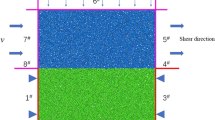Abstract
Binary-medium contact interfaces widely exist in rock engineering. They have significant impacts on the safety of rock engineering due to their poor shear behavior. A material of different strength is produced by pouring mortar of a different sand-to-cement ratio on the top of a rock-like mortar material (with the ratio of 1:1), thereby forming a binary-medium structural plane. Then, direct shear test is performed on the structural plane by applying different normal stresses. The shear strength parameters of the structural plane (cohesion \(c\) and friction angle \(\varphi\)) are obtained from the Mohr–Coulomb criterion. Moreover, the mechanical behaviors of the structural plane are compared with the unitary-medium specimen in the shearing process. A similar shear stress–shear displacement rule is observed in the shearing process. However, the peak and residual shear strengths of the binary structural plane are far lower than those of the unitary ones. The difference between the unitary and binary planes at cohesion \(c\) decreases with the increasing sand–cement ratio, whereas a up-down trend is observed in the friction angle \(\varphi\) with the increasing sand-to-cement ratio. When the upper and lower parts of the structural plane are different in sand-to-cement ratio, the cohesion \(c\) of the structural plane slightly increases with the increasing ratio of the upper specimen. However, when the two parts are identical in ratio, the cohesion of the structural plane reaches the peak, and its friction angle \(\varphi\) substantially increases with the increasing ratio of the upper part.








Similar content being viewed by others
References
Asadollahi P, Tonon F (2010) Constitutive model for rock fractures: revisiting Barton’s empirical model. Eng Geol 113:11–32
Bahaaddini M, Sharrock G, Hebblewhite BK (2013) Numerical investigation of the effect of joint geometrical parameters on the mechanical properties of a non-persistent jointed rock mass under uniaxial compression. Comput Geotech 49:206–225
Biscaia HC, Chastre C, Silva MAG (2013) Modelling GFRP-to-concrete joints with interface finite elements with rupture based on the Mohr–Coulomb criterion. Constr Build Mater 47:261–273
Cao Y, Ma S, Kang Y, Zhao Y, Zheng Y (2011) The experimental study on fracture process of similar rock material with different ductility. Proc Eng 26:1798–1802
Cao RH, Cao P, Fan X, Xiong XG, Lin H (2016) An experimental and numerical study on mechanical behavior of ubiquitous-joint brittle rock-like specimens under uniaxial compression. Rock Mech Rock Eng 49:4319–4338
Du S, Huang M, Luo Z (2010) Similar material study of mechanical prototype test of rock structural plane. Chin J Rock Mech Eng 29:2263–2270
Grasselli G (2005) 3D behaviour of bolted rock joints: experimental and numerical study. Int J Rock Mech Min Sci 42:13–24
Haque A, Kodikara J (2012) A simplified analytical model for predicting the shear behaviour of regular triangular rock/concrete joints under constant normal stiffness. Geotechnique 62:171–176
Kodikara JK, Johnston IW (1994) Shear behaviour of irregular triangular rock-concrete joints. Int J Rock Mech Min Sci Geomech Abstr 31:313–322
Lin WP, Tian KS, Zeng GP (1985) A study on the major factors effecting the shear strength of the cemented interface between concrete and bedrock. J Hydraul Eng 15:10–19
Liu J, Cao P, Li K (2015) A study on isotropic rock breaking with TBM cutters under different confining stresses. Geotech Geol Eng 33:1379–1394
Lu GY, Zhu ZQ, Liu QY, He XQ (2009) Failure mode and strength anisotropic characteristic of stratified rock mass under uniaxial compressive situation. J Central South Univ Technol 16:663–668
Suits LD, Sheahan TC, Seidel JP, Haberfield CM (2002) Laboratory testing of concrete-rock joints in constant normal stiffness direct shear. Geotech Test J 25:391–404
Tian HM, Chen WZ, Yang DS, Yang JP (2015) Experimental and numerical analysis of the shear behaviour of cemented concrete-rock joints. Rock Mech Rock Eng 48:213–222
Wang CJ, Yang YZ, Li YH (2008) Research and numerical analysis for mechanical behavior of rough interface. J Water Resour Archit Eng 6:35–38
Xia CC, Sun ZQ (2002) Engineering rock joint mechanics. Tongji Press, Shanghai
Xia CC, Yue ZQ, Tham LG, Lee CF, Sun ZQ (2003) Quantifying topography and closure deformation of rock joints. Int J Rock Mech Min Sci 40:197–220
Zhao LH, Zuo S, Li L, Lin YL, Zhang YB (2016) System reliability analysis of plane slide rock slope using Barton–Bandis failure criterion. Int J Rock Mech Min Sci 88:1–11
Zhao Y, Wang Y, Wang W, Wan W, Tang J (2017) Modeling of non-linear rheological behavior of hard rock using triaxial rheological experiment. Int J Rock Mech Min Sci 93:66–75
Zou J-F, Xia Z-Q, Dan H-C (2016) Theoretical solutions for displacement and stress of a circular opening reinforced by grouted rock bolt. Geomech Eng 11:439–455
Acknowledgements
This paper gets its funding from Project (51474249, 41562016) supported by National Natural Science Foundation of China; Project (2016CX019) supported by Innovation-driven Plan in Central South University; Project (SKLGDUEK1405) funded by the Open Projects of State Key Laboratory for Geo-mechanics and Deep Underground Engineering, CUMT. The authors wish to acknowledge these supports. The anonymous reviewer are gratefully acknowledged for his valuable comments on the manuscript.
Author information
Authors and Affiliations
Corresponding author
Rights and permissions
About this article
Cite this article
Lin, H., Wang, M. & Xu, W. Shear Behaviors of the Binary Structural Plane. Geotech Geol Eng 36, 939–948 (2018). https://doi.org/10.1007/s10706-017-0366-x
Received:
Accepted:
Published:
Issue Date:
DOI: https://doi.org/10.1007/s10706-017-0366-x




